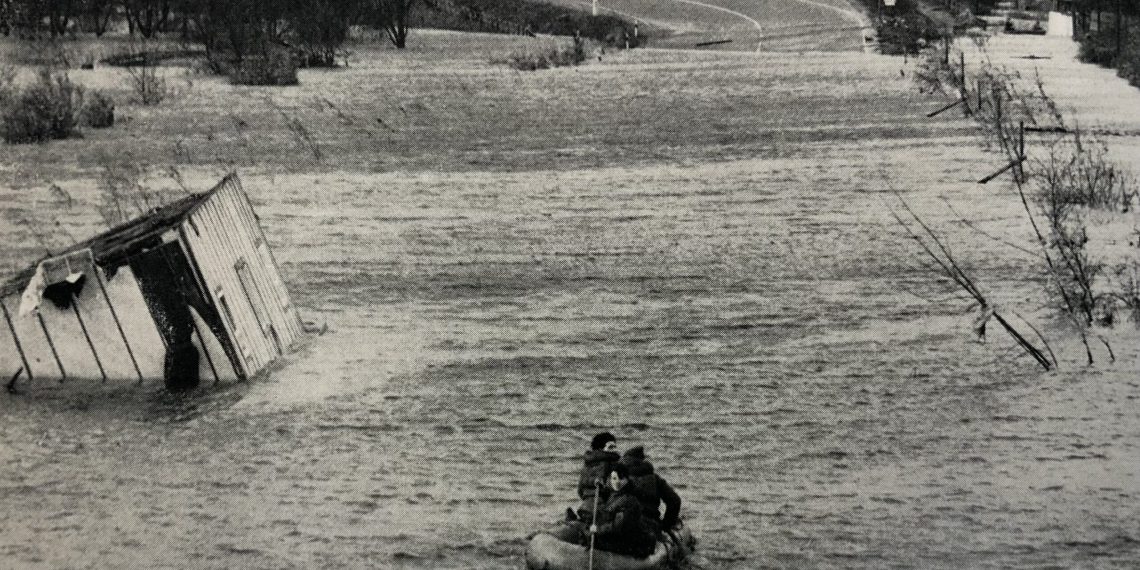In the night of February 17, 1962, a severe storm surge was announced for the North Sea coast. However, there was no talk of any danger to Hamburg. So the citizens of the Hanseatic city were completely unprepared when the Elbe washed the masses of water into the city. Many dikes broke and the south of Hamburg sank in the flood. That night, 315 people died, thousands were left homeless or even lost everything they owned.
Employees of the Hamburg University of Technology were also directly affected: “My father was training with the German Armed Forces in Hamburg in February 1962. He and his comrades were deployed to fish the numerous dead out of the water with a boat. He reported that they fastened the dead alongside their boats and brought them ashore. Relatives who saw their family members tied up like this collapsed by the dozen.”
Modern dike construction followed
Hurricane Vincinette swept across the country that night, bringing disaster with unprecedented storm surge levels. In more than 60 places, the dikes could not withstand the masses of water. Although the breaches were subsequently closed again, one thing was clear: the city of Hamburg needed a completely new flood protection concept. It quickly became clear that it was not possible to repair and raise the dikes. As a result, around 100 kilometers of completely new protective structures were built with a height of at least 7.20 meters above sea level.
Equipped for the future?
Professor Peter Fröhle at the Technical University of Hamburg is studying the consequences of global warming and its influence on the Elbe from a hydraulic engineering perspective. The head of the Institute of Hydraulic Engineering answers questions about how well equipped Hamburg will be in terms of flood protection in the future:
Will we have to expect more frequent storm surges in Hamburg in the future?
Yes. As a result of climate change and the associated rise in sea level, storm surges will be even higher in the future, given the same storm intensity. Water levels that used to occur once every hundred years will then also come upon us much more frequently, for example every five years. In addition, storms may become even more intense as a result of climate change, which would then further increase the frequency.
What impact would a storm surge have on Hamburg today?
The flood protection systems are very safe in Hamburg and also along the entire North Sea coast, which was most recently evident in December 2013. During storm Xaver, water levels occurred in Hamburg that were almost half a meter higher than in 1962. In Hamburg and on the North Sea coast, the flood protection system functioned practically smoothly, so no serious damage occurred. In the meantime, flood protection has become even better. Unfortunately, however, there is still no one hundred percent protection against natural disasters.
How high can the water rise before it’s “land under” again, and how can better forecasting methods help?
In the current construction program of the Free and Hanseatic City of Hamburg, it is planned to expand dikes and flood protection facilities to a height of at least 8.30 meters above sea level. If a water level does significantly exceed the eight-meter mark, forecasting methods are the basis for warning the population. A good forecast is also important for the authorities’ operational planning, so that they can then close mobile flood protection facilities, such as storm surge gates and barrages, and prepare and coordinate dike defense. The more precise and earlier the forecasts arrive, the simpler and easier it is to prepare for a storm surge. In Hamburg, the Storm Surge Warning Service is responsible for this.
What measures besides higher dikes has flood protection developed in the past, and what specifically are you researching?
In addition to dikes and flood protection walls, there are a variety of concepts to protect against flooding. These range from adapted construction methods and the creation of space for the water to dams or barrages designed to prevent the inflow of a flood wave. At the TU Hamburg, we are looking into the future of flood protection on the Tidal Elbe against the background of climate change. To this end, we identify and analyze conceivable options for future flood protection and evaluate them from a hydraulic engineering, water management, ecological and economic perspective. In addition to changes in tidal conditions, currents and water levels, we must also consider consequences for flora and fauna as well as for navigation and other uses. Our results will then be used to derive options for action in the future.

















